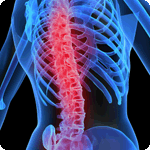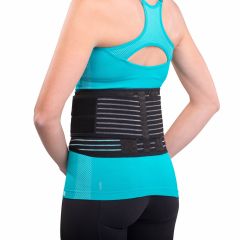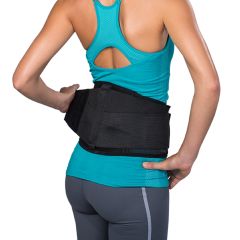Lower Back Pain
Causes of Low Back Pain
As people get older, their muscles and bones lose strength. The discs that cushion the vertebrae in your back also lose flexibility as we age. As a result, most back pain occurs in men and women ages 40 to 50. Injury and trauma may result in lower back pain, and it can occur during simple activities, such as:
- lifting heavy objects
- overstretching the back
- poor posture
- poor sleeping position
- sports accidents
- car accidents
- repeated injury to the back
- Herniated disk - a ruptured or injuries disk in your back
- Osteoporosis - decreased bone density and strength
- Sciatica - pain along the sciatic nerve
- Spinal degeneration - wear and tear of the disks in your back
- Spinal stenosis - narrowing of the spinal column
MANAGEMENT OF LOWER BACK PAIN
As with any injury, your doctor will be the best source of advice on the appropriate treatment method for your situation. Your doctor will perform a physical examination to determine the cause of your lower back pain and to determine a specific treatment. General pain relief for low back pain often begins with the use of hot and cold therapy. The cold helps numb away the pain and the heat helps to relax the muscles. We recommend the Aircast Back Cryo/Cuff with Cooler for cold therapy.
Sometimes rest may be suggested for a couple of days, but quick return to regular activity is most often recommended for low back pain treatment. Prolonged bed rest may make it harder to recover and may actually increase back pain due to weakened and tightened muscles. Exercise and physical therapy is recommended to help strengthen the muscles that support your spine and abdominal area. In some cases, a chiropractor may also help stretch the back and spinal structures.
Medications may also be used to help alleviate low back pain. Over-the-counter anti-inflammatory medications such as ibuprofen and aspirin may help reduce mild pain in the lower back. Your doctor may also prescribe other medications that aid in relieving nerve pain in the back.
Let your doctor know if pain persists.
Preventing Lower Back Pain
Here are some tips to avoid lower back pain and injury:
- Do exercises to keep the back muscles and abdominal muscles strong, such as abdominal crunches.
- Do daily back stretches and make sure to stretch before physical activity.
- Sit up straight and avoid slouching when standing and sitting.
- Avoid wearing high heels.
- If you work at a desk job, make sure your chair has proper support and that your table is at the proper height.
- If you work at a job that requires heavy lifting, make sure to lift with your knees, keep the object close to your body, and keep your back straight.
- Wear a back brace or lumbar support, which helps stabilize the lower back and provides compression. Back braces also help remind you to lift properly.
- When you do have to carry items, try to separate them out so that you don't carry them all at once.
- Make sure your mattress gives you proper support while sleeping at night.
- Eat healthy foods and maintain your weight at a wholesome level. Extra weight adds burden to your back and good foods provide proper nutrition.
- Avoid smoking, which can reduce blood flow and cause the disks in your spine to deteriorate.
SUPPORT & PROTECTION FOR THE LOWER BACK
View all Braces and Supports for Lower Back Pain





 Nearly every American experiences pain in the lower back at some point in their lives. This back pain can inhibit daily activity, and it's the leading cause of job-related disability in the United States. Nearly every movement we do involves the muscles, ligaments and bones of the lower back. Because of this, the lower back is susceptible to injury. Low back pain is not a disorder. It's actually a symptom that can come from a variety of causes.
Nearly every American experiences pain in the lower back at some point in their lives. This back pain can inhibit daily activity, and it's the leading cause of job-related disability in the United States. Nearly every movement we do involves the muscles, ligaments and bones of the lower back. Because of this, the lower back is susceptible to injury. Low back pain is not a disorder. It's actually a symptom that can come from a variety of causes.

